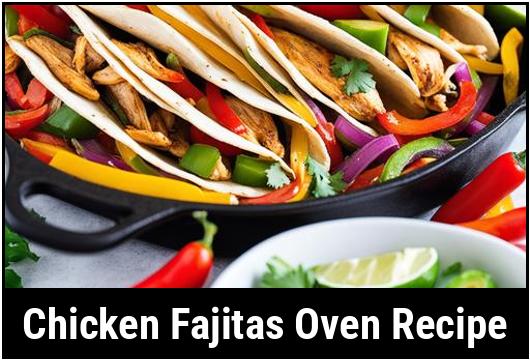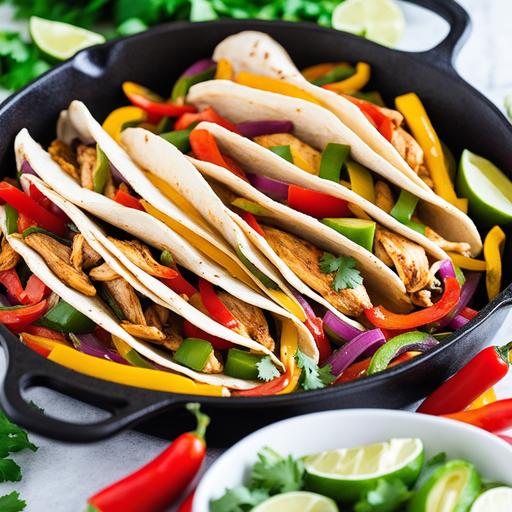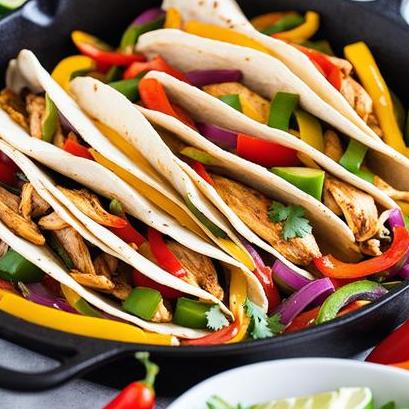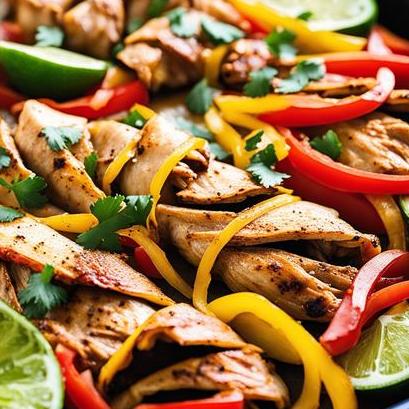- You are here:
- Home »
- Oven Recipes
- » The Ultimate Guide To Chicken Fajitas

The Ultimate Guide To Chicken Fajitas
Chicken fajitas are a delicious and fulfilling Tex-Mex dish that brings together succulent chicken, vibrant bell peppers, and a medley of spices. Whether you’re having a weeknight family dinner or entertaining guests, chicken fajitas are a crowd-pleasing option. In this comprehensive guide, we will delve into the food science behind achieving the perfect chicken fajitas, explore various culinary details, share tips and tricks, provide variations to cater to different tastes, and include a mouthwatering chicken fajitas oven recipe. So let’s get started!
Food Science: Achieving Tender and Juicy Chicken
The science behind achieving tender and juicy chicken fajitas lies in understanding the meat’s structure and moisture retention. When cooking chicken, heat causes proteins to denature and contract, leading to moisture loss. However, by marinating the chicken before cooking, we can mitigate this effect.
Marination
The first step is to select boneless, skinless chicken breasts or thighs, as they are leaner and more suitable for fajitas. To tenderize the meat and enhance flavor, create a marinade consisting of acidic elements like lime or lemon juice, oil, spices, and herbs. The acid helps break down the connective tissues, allowing the marinade to penetrate the meat, enhancing its tenderness and taste.
Cooking Temperature
To cook the chicken to perfection, we need to strike a balance between retaining moisture and ensuring it’s properly cooked. Oven cooking is an excellent method for evenly cooking chicken fajitas. Preheating the oven to around 400°F (200°C) guarantees a hot and quick cooking process that keeps the chicken juicy and prevents it from drying out.
Culinary Details: Selection, Cleaning, and Preparation
Now that we understand the fundamental principles behind chicken fajitas, let’s dive into the culinary details.
Selection
When selecting chicken for fajitas, opt for high-quality, organic poultry, if possible. Look for fresh, plump, and firm cuts. Ensure that the chicken does not have any unpleasant odor or discoloration, as these may indicate spoilage.
Cleaning
Once you’ve chosen your chicken, it’s time to clean it thoroughly. Rinse the chicken breasts or thighs under cold running water, and pat them dry using paper towels. Be cautious about cross-contamination by maintaining separate cutting boards and utensils for raw chicken.
Preparation
Next, it’s essential to trim any excess fat from the chicken. A leaner cut will result in healthier fajitas without compromising flavor. It’s also beneficial to slice the chicken into thin, uniform strips. A thinner cut ensures faster and more even cooking.
Tips for Perfect Chicken Fajitas

Achieving the best possible chicken fajitas requires some insider tips and tricks. Let’s explore a few:
Searing for Flavor
To enhance the flavor of your chicken fajitas, sear the marinated chicken strips on high heat in a skillet before transferring them to the oven. This step adds a delightful caramelization and depth of taste.
Balancing Spices
Finding the perfect balance of spices is crucial for a well-rounded chicken fajita dish. A harmonious blend of paprika, cumin, garlic powder, chili powder, and salt adds warmth and complexity. Experiment with the amount of each spice to customize the flavor according to your preferences.
Adding Sautéed Bell Peppers and Onions
While the chicken is the star of the show, don’t forget to include the vibrant and flavorful bell peppers and onions. Sauté them separately for a short time to retain some crunchiness, and then combine them with the chicken in the oven for a perfect flavor harmony.
Recipe: Chicken Fajitas Oven Style

After exploring the food science, culinary details, and tips, it’s time to put everything together with a delectable chicken fajitas oven recipe.
Ingredients:
-
1.5 lbs (680g) boneless, skinless chicken breasts or thighs
-
1 red bell pepper
-
1 green bell pepper
-
1 yellow bell pepper
-
1 medium-sized onion
-
2 tablespoons olive oil
-
Juice of 2 limes
-
4 cloves of garlic, minced
-
1 teaspoon paprika
-
1 teaspoon ground cumin
-
1 teaspoon garlic powder
-
1 teaspoon chili powder
-
Salt to taste
-
Freshly ground black pepper to taste
-
Tortillas for serving
-
Optional toppings: sour cream, shredded cheese, guacamole, salsa
Instructions:
-
In a bowl, combine the olive oil, lime juice, minced garlic, paprika, cumin, garlic powder, chili powder, salt, and black pepper. Mix well to create the marinade.
-
Slice the chicken breasts or thighs into thin, even strips. Place the chicken in a resealable plastic bag and pour the marinade over the chicken. Seal the bag and allow it to marinate for at least 30 minutes, or ideally refrigerate overnight.
-
Preheat the oven to 400°F (200°C) and line a baking sheet with parchment paper.
-
Remove the chicken from the marinade, shaking off any excess, and place it on the prepared baking sheet. Keep the remaining marinade for later use.
-
Slice the bell peppers and onion into thin strips. In a skillet, sauté the bell peppers and onion in some olive oil over medium-high heat until slightly softened, but still crispy. Remove from heat and set aside.
-
In the same skillet, sear the marinated chicken strips on high heat for 2-3 minutes on each side until lightly browned.
-
Transfer the seared chicken to the oven and bake for 10-12 minutes or until the internal temperature reaches 165°F (74°C) using a meat thermometer.
-
Remove the chicken from the oven, and while it rests for a few minutes, place the sautéed bell peppers and onions on the same baking sheet.
-
Return the baking sheet to the oven for an additional 2-3 minutes to heat the vegetables through.
-
Once everything is cooked to perfection, assemble your chicken fajitas by placing strips of chicken, sautéed bell peppers, and onions onto warm tortillas. Add your desired toppings such as sour cream, shredded cheese, guacamole, or salsa.
-
Roll up the tortilla tightly and enjoy the flavorful, juicy, and wholesome chicken fajitas.
Ensuring the Right Doneness

It’s essential to ensure that your chicken fajitas are cooked to perfection, neither undercooked nor overcooked. As mentioned above, the chicken should reach an internal temperature of 165°F (74°C) to be safe to consume. Using a meat thermometer will help you avoid any guesswork and achieve the desired level of doneness.
Overcooking and Undercooking
Overcooking chicken results in dry, tough meat, while undercooking can be a health risk. Undercooking chicken may expose you to bacterial infections such as salmonella. By following the recommended cooking time and using a meat thermometer, you can avoid these pitfalls and savor succulent, safe chicken fajitas.
Variations: Customize to Suit Your Taste

As with any versatile dish, chicken fajitas can be tweaked to cater to various tastes and dietary preferences. Here are a few popular variations to consider:
Protein Alternatives
While the recipe outlined above focuses on chicken, you can experiment with protein alternatives like beef, shrimp, or tofu. Each protein will bring its unique flavors to the table, allowing you to diversify your fajita options.
Vegetarian or Vegan Options
Easily cater to vegetarian or vegan diets by substituting the meat with marinated and grilled vegetables like portobello mushrooms, zucchini strips, or soy-based meat alternatives. The marinade provides an array of flavors that will satisfy even non-meat-eaters.
Gluten-Free Adaptation
For those avoiding gluten, serve your flavorful fajitas on gluten-free tortillas or swap the tortillas altogether by serving the chicken, bell peppers, and onions on a bed of nutritious quinoa or cauliflower rice.
Conclusion
Chicken fajitas are a versatile and exciting dish that combines succulent chicken, sautéed bell peppers, and onions with a perfect blend of spices. Through understanding the food science behind them, ensuring proper cooking temperatures, and following essential culinary details, you can create the ultimate chicken fajitas. The recipe provided offers a great starting point, but don’t shy away from exploring variations to customize your dish. So, gather your ingredients, heat up your oven, and embark on a Tex-Mex culinary adventure as you whip up a mouthwatering batch of chicken fajitas that will delight your taste buds and leave no plate empty. Enjoy!
Sources
FAQS On Chicken Fajitas Oven Recipe
What Ingredients Are Necessary To Make Chicken Fajitas In The Oven?
The essential ingredients to make chicken fajitas in the oven are skinless, boneless chicken breasts, bell peppers, onions, olive oil, and fajita seasoning. You can also add other seasonings like garlic powder, chili powder, or cumin to enhance the flavor of the dish.
How Long Should I Cook Chicken Fajitas In The Oven?
Chicken fajitas typically take 20-25 minutes to cook in the oven at 400°F. However, the cooking time may vary depending on the thickness of the chicken breasts or the size of the vegetable slices. You should aim for the chicken to reach an internal temperature of 165°F and for the vegetables to be tender but not overcooked.
Can I Prepare Chicken Fajitas In Advance And Cook Them Later?
Yes, you can marinate the chicken and vegetables together in a resealable bag or a baking dish and store it in the refrigerator for up to 24 hours. When ready to cook, remove the dish from the fridge and let it come to room temperature before placing it in the oven.
What Sides Can I Serve With Chicken Fajitas In The Oven?
There are many sides that pair well with chicken fajitas such as warm tortillas, guacamole, shredded cheese, sour cream, salsa, beans, or Spanish rice. You can also top the fajitas with fresh cilantro, lime wedges or diced tomatoes for extra flavor.
Can I Substitute Chicken With Other Meats For This Recipe?
Yes, you can use other meats like steak, shrimp or tofu instead of chicken in this recipe. Adjust the cooking time accordingly and ensure that the meat reaches the recommended cooking temperature for safety. You may also need to adjust the seasonings to suit your taste preferences.



